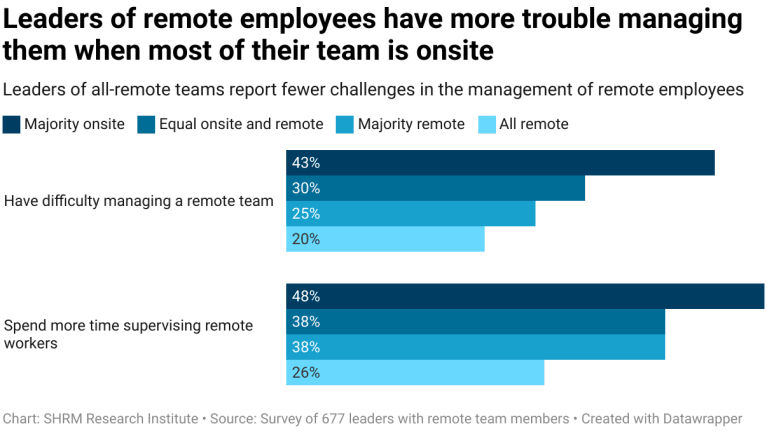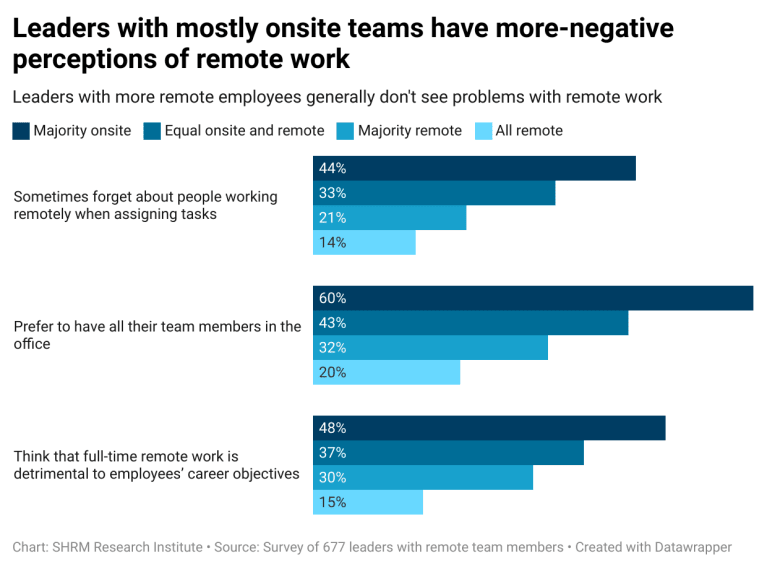The COVID-19 pandemic has revealed new possibilities for working remotely. Many leaders have had to adjust to managing remote workers, regardless of personal preferences; in many cases, it was a trial by fire. And the phenomenon isn’t likely to go away soon. Nearly half of the 1,702 workers recently surveyed by the Society for Human Resource Management (SHRM)—48 percent—said they are definitely looking for a remote position for their next job.
As remote work has gone from exceptional to ordinary for millions of people, new concerns have arisen about how leaders can effectively manage a mix of remote and onsite workers. Evidence to support these concerns includes SHRM’s previously reported statistics from 2021, which painted a somewhat negative picture of leaders’ perceptions of remote workers.
Now that leaders have had more experience with remote work and workers, the SHRM Research Institute sought to reassess their perceptions in 2022. We asked 677 leaders who supervise remote workers about 1) their difficulties managing remote workers and 2) fair treatment of and expectations for remote workers in the future.
The proportions of onsite to remote workers for these supervisors varied. They included a majority of onsite workers, an equal number of onsite and remote workers, a majority of remote workers, and only remote workers. (Leaders with only onsite workers were excluded from the sample.)
Difficulties Managing Remote Workers
Overall, we found that leaders in 2022 reported more positive perceptions of and experiences with remote workers, compared to 2021. But there is still potential for negative impacts on those workers.
Most leaders with mixed-location teams agreed that critical work functions are no more difficult with remote workers than with onsite workers. The majority of supervisors said activities such as communicating, brainstorming, and judging employee performance and efficiency (68 percent, 64 percent and 63 percent, respectively) are similarly difficult among onsite and remote workers in any proportion on their teams.
However, leaders with predominantly onsite workers were more likely to be having difficulty managing their remote workers (43 percent with a majority of onsite workers versus 20 percent with only remote workers) and to be spending more time supervising them (48 percent with a majority of onsite workers versus 26 percent with only remote workers). Greater support in the form of training or tools may be useful for these leaders.
The good news is that most leaders are not reporting such difficulties.
Fair Treatment of Remote Workers
Remote and onsite workers are both treated fairly, according to most leaders of partially to fully remote teams. They agree, for instance, that opportunities for promotions (72 percent of leaders) and considerations for future managerial roles (69 percent of leaders) are just as likely for remote workers as for onsite workers. More than 3 in 4 leaders (76 percent) also agree that male and female remote workers receive similar treatment.
Only 37 percent of leaders think that remote workers are considered more expendable than onsite workers. Notably, though, this drops to 14 percent among leaders whose teams are entirely remote (which may be due to their organization, as a whole, working remotely).
However, leaders with predominantly onsite workers are more likely to agree that:
- They sometimes forget about remote workers when assigning tasks (44 percent with a majority of onsite workers versus 14 percent with only remote workers).
- They prefer to have all their team members in the office (60 percent with a majority of onsite workers versus 20 percent with only remote workers).
- They think that full-time remote work is detrimental to employees’ career objectives (48 percent with a majority of onsite workers versus 15 percent with only remote workers).
These results signal that the remote workers most vulnerable to unequal treatment are those whose leaders have relatively few remote workers on their teams. This may have serious implications for workplace equity, because members of marginalized groups tend to prefer remote work. Therefore, these research findings are important for leaders with remote and onsite workers to consider in their support of equitable workplaces.
A Brighter Outlook
The results of our 2022 research show that the majority of leaders who supervise remote workers have mostly positive views of remote work. This is a change in their perceptions compared to what was reported in 2021.
It is important to note, however, that leaders whose teams consist of mostly onsite workers tend to have more-negative views about remote work.
Perhaps, as leaders gain more experience with and exposure to remote workers, we will see the positive trend continue in their perceptions and expectations of remote work.
SHRM-certified HR professionals will recognize the crucial relationships between this research and the SHRM Body of Applied Skills and Knowledge, particularly two behavioral competencies, Analytical Aptitude and Diversity, Equity & Inclusion, and two functional areas of HR expertise, Workforce Management and Employee & Labor Relations.
Methodology: A sample of 677 leaders supervising at least some remote workers was surveyed online April 1-7, 2022. Of these leaders, 37 percent had a majority of onsite workers (average of 11 team members); 31 percent had an equal number of onsite and remote workers (average of 10 team members); 19 percent had a majority of remote workers (average of 11 team members); and 13 percent had only remote workers (average of eight team members). The leaders surveyed had a median age of 45 years old, 39 percent had been employed at their current organization for at least 10 years, 53 percent were female and 76 percent were white.
Katrina P. Merlini is a senior researcher of thought leadership for the SHRM Research Institute. Mark Smith is the SHRM Research Institute’s director of HR thought leadership.
Techyrack Website stock market day trading and youtube monetization and adsense Approval
Adsense Arbitrage website traffic Get Adsense Approval Google Adsense Earnings Traffic Arbitrage YouTube Monetization YouTube Monetization, Watchtime and Subscribers Ready Monetized Autoblog
from Remote Workers – My Blog https://ift.tt/WPYHMRj
via IFTTT



No comments:
Post a Comment